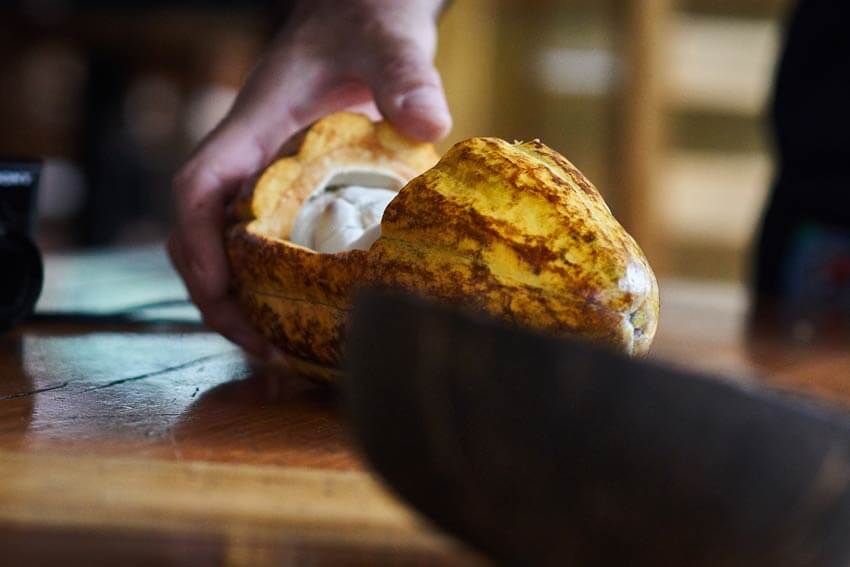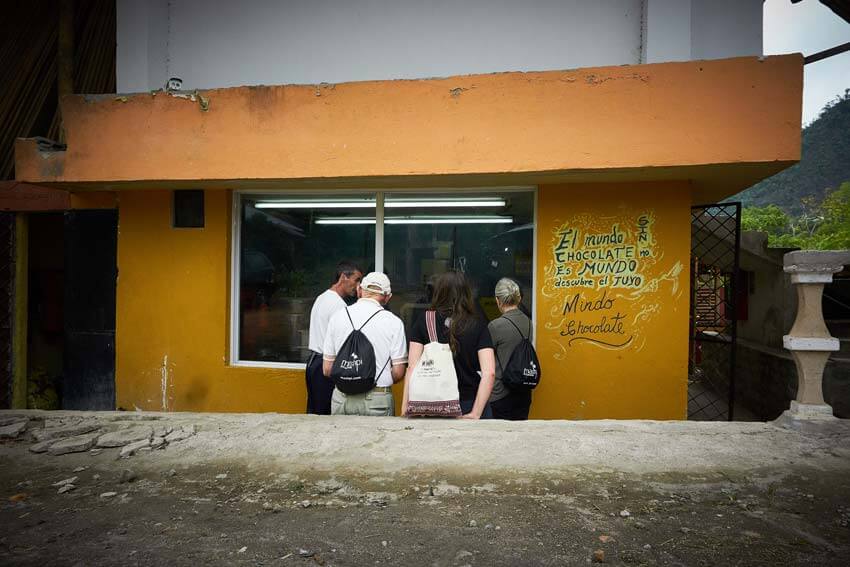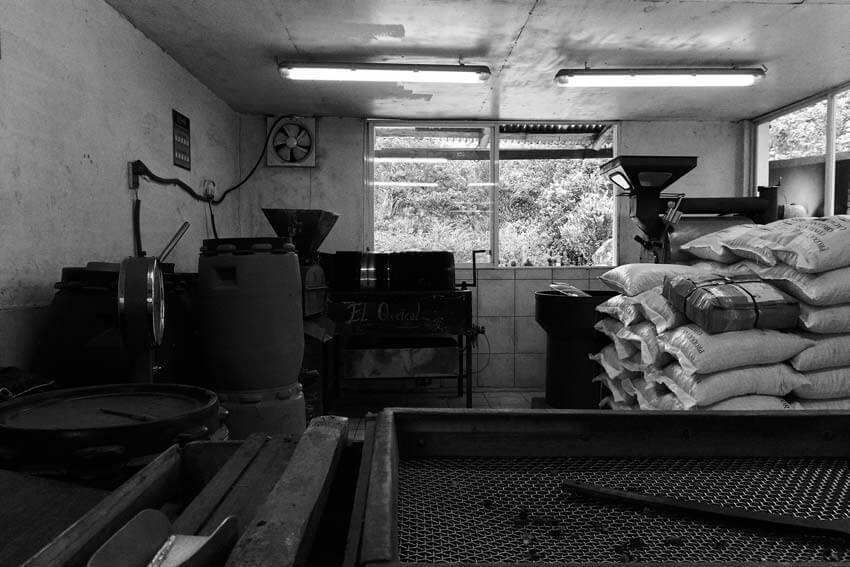

Fine chocolate has found a top-quality niche in Ecuador’s fertile cacao farms. The small country dominates over half the market for the exceptional Cacao Arriba Fino de Aroma bean, and its influence is just beginning to surface. But there’s more to this success story than the quality of Ecuadorian cacao: it’s the small cacao farmers, and their passion for the raw product, that are revitalizing the market from the inside out.

In the last decade, Ecuador has inched its way back into the world’s chocolate map. Yes, a chocolate map exists — and it mainly consists of a few countries producing the raw cacao bean, and the rest of the world (mainly the West) devouring it in the form of a sweet, sweet chocolate bar. But let’s trace back a bit and bolden our statement about Ecuador’s positioning along this map: today, it would be at the epicenter. As the world craves more of the Fino de Aroma beans for gourmet products, Ecuador has risen to the top as premier exporter of this cacao variety.
The positive economic implications of this cacao boom are obvious, but the ripple-effect on Ecuadorian culture and national pride are also worth talking about. Chocolate hqs now caught the interest of travelers who want to taste Ecuador’s black gold as much as they want to see the blue-footed booby’s mating dance or stand on the equator line. For Ecuadorians, this has become a source of pride. Pride for the product itself, and for the country’s unique geographical position, providing the rich soil to promote its growth.
A BRIEF HISTORY OF CACAO IN ECUADOR
Until recently, the cacao bean was thought to have originated in México. A 2006 archeological study contradicted this common belief when tiny remnants of cocoa were found in ceramic pottery in Ecuador’s Amazonian province of Zamora-Chinchipe. This finding suggests the harvest and consumption of cacao beans dates back to more than 5,000 years ago, longer than any other place in the world. Historically, many cacao farms were located upwards of the Guayas river, so the country’s native beans came to be called ‘Arriba’ (meaning ‘up’) or ‘Nacional’. External market factors drove two significant cacao booms, one from 1779-1842, and a second from 1895-1913, during which the country enjoyed the distinction of primary exporter. But while the market has driven its changing activity and demand, one thing has remained constant for Ecuador’s fine bean: an equatorial climate and a rich, fertile soil nourished by volcanoes, jungles, and coexisting ecosystems.
THE DEMAND FOR ECUADORIAN SPECIALTY CHOCOLATE
Put simply, the market for Ecuadorian cacao has historically been characterized as such: Ecuador provides over 60% of the world’s finest cacao (‘fino de aroma’), while Europe, Asia, and North America provide the craft for refining it. These regions control the gourmet chocolate industry, which relies on this raw crop for an elegant product with a distinguished flavor profile. Fino de Aroma beans represent only 5% of the world’s entire cocoa production, and Ecuador controls more than half of that, meaning the country is playing its cards right — at the very top, and way ahead of regional competitors such as Venezuela, Panamá, and México.


So, why is Fino de Aroma so sought after? Gourmet and specialty chocolate producers highlight its purity, flavor, and fragrance as essential to elevating the quality of a finished product. Cacao beans reflect the flavors and aromas of their farm’s surroundings, and Ecuador’s abundant natural resources have transmitted their richness onto the crop. The fine Ecuadorian bean is characterized by a combination of flavors, including: cherries, raisins, berries, citrus, nuts, caramel, honey, sugarcane, almonds, peanuts, and a variety of flowers. And because each bean carries a different flavor profile (depending on where they were grown), the aroma and finished product are deliciously complex.
Chocolatiers around the world credit Ecuador’s terrain and biodiversity for the richness of its cacao — and they want more. The quality of Ecuador’s cacao is inextricably linked to the country’s natural endowment, which includes mineral-rich volcanic soil and a tropical equatorial climate. Take the same exact cacao bean and plant it anywhere else in the world, and it won’t be nourished in the same way (and certainly won’t be as delightful) as in this gem of a country. Now on the bucket list of every respectable chocolatier, Ecuador has some refined chocolate products of its own, the result of a thriving local market.
PACARI: A SUCCESS STORY
Ecuadorians — especially farmers — aren’t recognizing this fame as something of the recent decade. They see cacao as integral to the country’s history, and Ecuador as the origin of the world’s love affair with chocolate. It is this pride that rekindled the local specialty chocolate market, making it possible to find Ecuador’s finest product as easily in Quito as you would in Switzerland. And the only thing finer than the product is Ecuador’s ability to accommodate foreign demand for the raw product, while carving out a special place for it back home — where it has been all along.
Santiago Peralta and Carla Barbotó, Ecuadorian chocolate makers and founders of Pacari, wanted to turn the exporting trend on its head. They knew it was valuable to be the world’s premier provider of raw cacao, but thought it unacceptable that nobody in the country knew how to make chocolate. Together, the couple developed a fair-trade business model that honored the Ecuadorian cacao farmers whose hands are the first to touch the prized commodity. Their bars are also fused with Ecuador’s best fruits, herbs, and flowers, pairing the fine cacao with other iconic flavors in the region. The company’s success has contributed to cacao production becoming a sustainable source of income for farmers, and it has motivated farmers of other crops to join in the cacao market. This is where chocolate’s origin story comes full circle.
Pacari means ‘nature’ or ‘awakening’ in Quechua, and the name sums up the business’s primary objective: to tell Ecuador’s story of chocolate, by making its own. When these entrepreneurs started working with local farmers, they began to understand the deep ties they had to the land and the farming process. This relationship, or the concept of terruño, is embedded in Pacari’s ethos and manifest in their refined products from various cacao-growing regions such as Esmeraldas, Manabí, and Los Ríos. Now the company is known not only for its award-winning chocolate bars, but for its alternative business model that quickly gained a following. After Pacari’s success, other Ecuadorian companies started experimenting with their own chocolate, and even foreign companies started to produce their bars in the country.
THE CHOCOLATE-MAKING PROCESS, AND WHERE YOU CAN WITNESS IT


While the flavor and quality of cacao beans worldwide is variable, there is one constant: the process of turning it into chocolate. Cacao trees bear pods that carry approximately 40-50 cacao beans each. The beans are packed tightly into the pod and surrounded by a sweet, fruity pulp that contrasts the raw, bitter flavor of the raw cacao bean. Once the beans are taken out of the pods, they are stored in wooden boxes and covered with leaves for the fermentation process. After a week of developing flavor, the beans are dried, roasted, and hulled. The nibs are turned into a liquid, mixed with cacao butter and cane sugar over a fire until melted together. Ecuadorian craft also makes thorough use of the cacao tree and pod; the pulp, leaf, and butter are attributed countless medicinal properties, and collected for future use.
If you’re visiting Ecuador, you have this third cacao boom to thank for the possibility of witnessing this process first-hand. As the country’s specialty chocolate market grows, more and more farmers are opening their doors to local and foreign visitors that are curious about how this valuable crop gets from pod to bar — and into their mouth. Takiri offers a unique experience in the cloud forest of Mindo, where you can tour a small cacao farm, participate in a fun chocolate tasting, and enjoy a chocolate-inspired lunch. It is a one-of-a-kind tour that gets you intimately engaged with the chocolate-making process, while also supporting the domestic market. And that might be the biggest draw — as you see, smell, feel, and taste cacao’s living story in Ecuador, you’ll also get to be a part of it!
